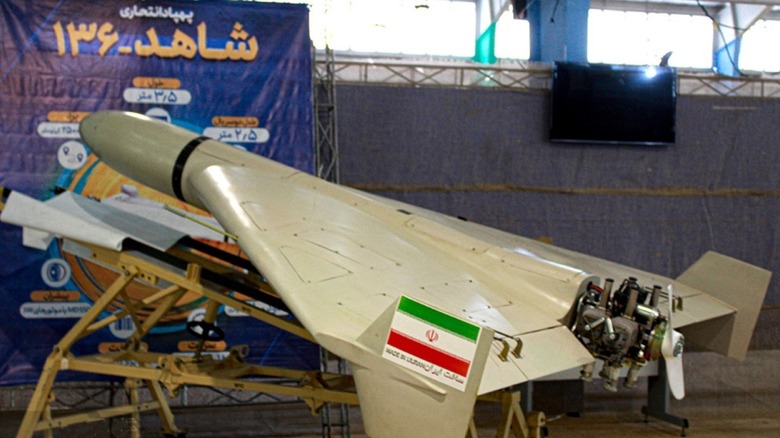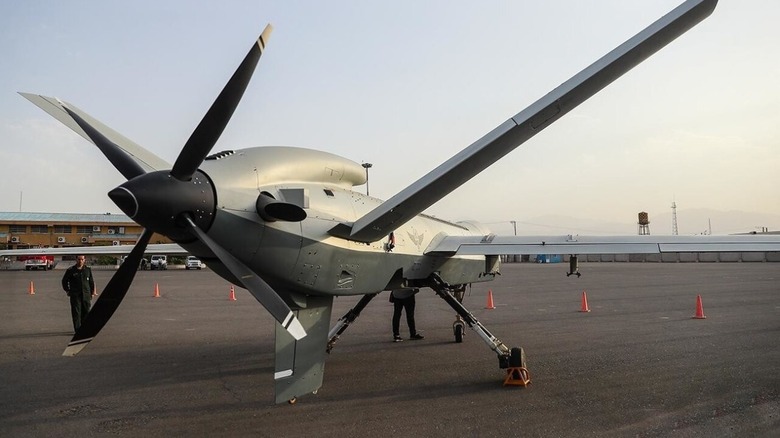Iran And Russia Are Using Shahed Drones: What Are They And Why Are They So Dangerous?
Though there is technically a difference between a drone and a UAV, both terms are becoming intrinsic parts of modern warfare. One of the primary virtues of such a device is its versatility and, in some cases, its affordability. Some of the most formidable military drones certainly aren't cheap (the total cost of the unit for a formidable MQ-9 Reaper drone is $56.5 million, fiscal 2011), but it's possible to adapt drones into deadly weapons for a relatively low cost. One prominent and terrifying example of this is the Shahed drone, which has been utilized in Russian attacks on Ukraine and by Iran against Israel.
Shahed drones are so named because, according to the U.S. Department of the Treasury, they are created by or in association with the Shahed Aviation Industries Research Center in Iran. They are notably loitering munitions drones that have been causing devastation for years, with the department noting in November 2022 that they had been "used in devastating attacks against civilian infrastructure in Ukraine." The piston-powered Shahed-136, commonly used in the conflict, has a range of up to around 1555 miles and a speed of approximately 115 mph.
The Shahed drone family has some key virtues that make it especially dangerous. It is comparatively very cheap to deploy, built at a cost of up to around $50,000. With a 40 kilo payload, this translates to quite a lot of bang for the user's buck. They're perfectly suited, then, to one of the most deadly drone strategies in warfare: Swarming. Operators have also developed tactics to boost their effectiveness, with the Kyiv Independent stating that "Russia's Shahed drones usually attack along riverbeds and roads, as it's harder for anti-aircraft radar to spot the Shaheds when they fly low over a river."
The key to the Shahed drone's power
Some drones in the family only hit their target around one-tenth of the time, and the variants that have been used by Russia and Iran typically lack the technology to do any more than follow a predetermined path. While an individual drone of this type would generally be rather ineffectual, then, their great virtue is that they can be used en masse. Benjamin Jensen, Futures Lab director, notes for the Center for Strategic & International Studies, "The Shaheds are used as much to saturate air defenses as they are to attack targets, cluttering radar screens and forcing command centers to make decisions about where to fire their more capable surface-to-air missiles like the Patriot."
In addition to this, the flipside to their typically simplistic flight patterns is that they also don't require anything else on the operators' end. They're considerably powerful weapons, yes, but they're also logistical nightmares to face in great numbers. It's this ability to require a lot of resources from the target while not demanding much at all from the user that makes them so dangerous.
The wider Shahed family, though, incorporates some rather different drones too. The Shahed- 149 Gaza drone, for instance, is a very similar model to the mighty MQ-9 Reaper, which is currently in the process of being retired from the U.S. Air Force. The Shahed-149 boasts compatibility with Hellfire and Paveway II missiles, as well as advanced radar and navigation and a T-76 Honeywell engine. A Shahed drone, depending on its type, can be a rather simple fire and forget affair, highly threatening in numbers, or a more sophisticated weapon armed with a formidable arsenal of its own. Either way, it's a danger to reckon with.

